A recent RMIT study found that one in five Melbourne vegie patches had high levels of lead contamination in the soil.i The results were worse for Sydney. Which is pretty dispiriting for those interested in healthy home grown food. But not altogether surprising to us. At Very Edible Gardens, we’ve been testing some of our clients’ backyards for years, and we’ve seen similar trends.
To be clear, in both cases they aren’t random samples, but based on samples submitted by people with some cause for concern. So the true number of contaminated patches is probably significantly lower. But still. We need to take it seriously, especially where children are concerned as they can be more gravely affected by lead poisoning, including developmental delays.ii
Fortunately the science shows that there are lots of effective mitigation strategies, and we’ve compiled them for you. So, what to do if you’re a food grower and you’re worried about your soil’s lead levels?
#1 Get Tested.
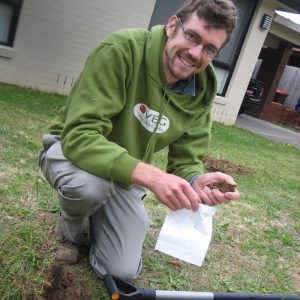 Particularly if you’re near major roadways, or if you’re in an older suburb and especially if you have a painted house (or there was once one on the site) it’s worth getting tested. The VegeSafe project at Macquarie University offer the testing of five soil samples for a small donation of $20. You can’t do better than that. Check out their website for instructions. If your tests come back in a realm of concern – officially above 300 parts per millioniii (ppm), although let’s say 150-400ppm (and lower where children are concerned) – follow our advice closely. If it’s higher again, you might want to skip to points #9 & #10 and below.
Particularly if you’re near major roadways, or if you’re in an older suburb and especially if you have a painted house (or there was once one on the site) it’s worth getting tested. The VegeSafe project at Macquarie University offer the testing of five soil samples for a small donation of $20. You can’t do better than that. Check out their website for instructions. If your tests come back in a realm of concern – officially above 300 parts per millioniii (ppm), although let’s say 150-400ppm (and lower where children are concerned) – follow our advice closely. If it’s higher again, you might want to skip to points #9 & #10 and below.
#2 Wash. Wash your hands, and wash your vegetables.
Plants are fairly good at keeping lead out of them in normal circumstances (see our note on acidity in #4). But if they are covered in soil, or even an invisible layer of dust on fruit or leafy greens, you may be consuming lead from the soil that way. Likewise if it’s on your hands, or you bring it into the house on your clothes, you may ultimately ingest some of it. A splash of vinegar in the washing water helps dislodge lead dust from your fruit and vegies.iv
#3 Add organic matter.
A good soil should be spongey, crumbly and chocolately brown. If that’s not what you see, adding organic matter will help. Organic matter helps bind the lead up, and makes it less available to plants. So compost, compost, compost. Dig it into the top 20cm of your veggie bed. Besides reducing lead uptake, it’s an all round solution to healthier, more productive plants.v
#4 Home test your soil’s pH.
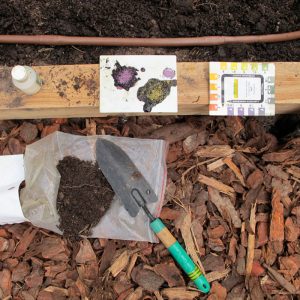 A simple liquid pH kit costing less than $20 gives you hundreds of tests you can do at home. A low pH means you have an acid soil, 7 is neutral, and above that is alkaline. If your soil tests below 6.5, you will want to add garden lime to neutralise the soil, because in acidic conditions lead is more soluble and more readily up-taken up by your plants.vi
A simple liquid pH kit costing less than $20 gives you hundreds of tests you can do at home. A low pH means you have an acid soil, 7 is neutral, and above that is alkaline. If your soil tests below 6.5, you will want to add garden lime to neutralise the soil, because in acidic conditions lead is more soluble and more readily up-taken up by your plants.vi
#5 Add a high-phosphorous fertiliser.
Phosphate reacts with soluble lead in the soil, reducing its bioavailability.vii Organic gardeners avoid super phosphate but unfortunately it’s probably the best strategy in this case (or some bat guano if you can get your hands on it!) because the favoured organic source – rock phosphate – does not break down and do anything useful in alkaline or neutral soils, and we’re aiming for neutral soils (see point #4).
#6 Mulch.
Mulch not only protects your the health of your soil, it prevents soil from flying up onto your crops when you’re watering, or it’s raining, or there are high winds.
#7 Grow fruit crops, not root crops
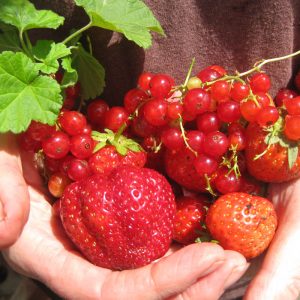 As a general rule, the worst affected vegetables are incompletely washed or peeled root vegetables. If you do grow them you must peel! Leafy greens can be somewhat effected, especially lettuce, although much of this may be surface borne dust.viii The least affected parts of plants are the fruiting parts – including all the ‘fruit’ we consider vegetables. There’s very little danger of lead toxicity in anything from tomatoes, strawberries and pumpkins to fruit trees in general.ix x
As a general rule, the worst affected vegetables are incompletely washed or peeled root vegetables. If you do grow them you must peel! Leafy greens can be somewhat effected, especially lettuce, although much of this may be surface borne dust.viii The least affected parts of plants are the fruiting parts – including all the ‘fruit’ we consider vegetables. There’s very little danger of lead toxicity in anything from tomatoes, strawberries and pumpkins to fruit trees in general.ix x
#8 If you have chickens, keep them separate from the soil.
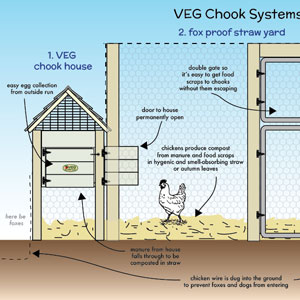 Chickens that scratch and peck in contaminated soil or paint flakes can pass the lead on in the form of eggs (or meat).xi But chickens live to scratch – it’s cruel to keep them on concrete. So we recommend testing before getting chickens. In untested soils, or soils of moderate concern, always provide deep litter, deep enough that the chickens rarely make contact with the original soil. We use free council or arborist mulch in their run, and straw, wood shavings or autumn leaves in their compost-making straw yard. (A straw yard is highly recommended – see here to learn about them.)
Chickens that scratch and peck in contaminated soil or paint flakes can pass the lead on in the form of eggs (or meat).xi But chickens live to scratch – it’s cruel to keep them on concrete. So we recommend testing before getting chickens. In untested soils, or soils of moderate concern, always provide deep litter, deep enough that the chickens rarely make contact with the original soil. We use free council or arborist mulch in their run, and straw, wood shavings or autumn leaves in their compost-making straw yard. (A straw yard is highly recommended – see here to learn about them.)
#9 Use raised beds. Ideally wicking beds.
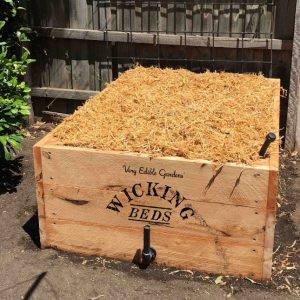 Ok, we’ve got some skin in the game here. But one of the reasons we use raised beds in our business is because it allows us to use imported soil. Wicking beds (which have layer of impermeable plastic and a water reservoir beneath the soil) are completely separated from the original soil and come with a host of other benefits besides. See www.wickingbeds.com.au.
Ok, we’ve got some skin in the game here. But one of the reasons we use raised beds in our business is because it allows us to use imported soil. Wicking beds (which have layer of impermeable plastic and a water reservoir beneath the soil) are completely separated from the original soil and come with a host of other benefits besides. See www.wickingbeds.com.au.
#10 Isolate or remove any highly contaminated soil
What ‘highly contaminated’ means might depend on your situation. I for one would not like to see children getting dirty every day in soil that was above about 70ppm. But if it’s for growing veggies, mostly for adults, and you follow the above advice, your tolerance might be closer to 300-400ppm. (My partner and I had over 400ppm levels in our extensive veggie patch for years, while also eating lots of wild food from urban parklands as authors of The Weed Forager’s Handbook, yet neither of us had any detectable lead in blood tests.) We’ve seen soils above 1000ppm though, and certainly at this point we recommend removing or deeply burying the soil. Lead is not very mobile in the soil (unless the soil is highly acidic) so it tends to stay down there. You can add geotextile fabric to prevent worms and soil organisms slowly mixing it through to higher levels.
#11 Eat a healthy diet.
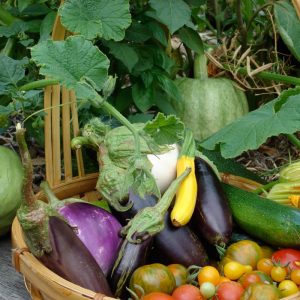 …of which a well maintained veggie patch and home grown fruit and nuts can be a very important part. A good diet with adequate amounts of calcium and phosphorous reduces absorption of dietary lead.xii xiii It’s not entirely coincidental that these same two nutrients help reduce uptake of lead in plants. Dietarily, seaweedxiv and spirulinaxv have both been shown to bind to heavy metals and remove them from the body, although it’s not clear from the studies whether you have to eat them at the same time as potentially contaminated foods. So to be safe put spirulina in everything. Ok, I’m joking, but I seem to know people that have tried…
…of which a well maintained veggie patch and home grown fruit and nuts can be a very important part. A good diet with adequate amounts of calcium and phosphorous reduces absorption of dietary lead.xii xiii It’s not entirely coincidental that these same two nutrients help reduce uptake of lead in plants. Dietarily, seaweedxiv and spirulinaxv have both been shown to bind to heavy metals and remove them from the body, although it’s not clear from the studies whether you have to eat them at the same time as potentially contaminated foods. So to be safe put spirulina in everything. Ok, I’m joking, but I seem to know people that have tried…
That’s it. These tips should help you grow food more safely.
One final note. Painting and renovating.
We don’t believe growing food is anything like the most concerning issue around urban lead poisoning. That would have to go to renovations and painting. Old paints were up to 50% lead, and at a house I lived at – even with layers of newer paint on top – our paint tested at 13% lead. When the safe level in food is measured in parts per million (around 0.00003% lead for veggies is the Food Standards Australia New Zealand limit) it’s easy to see how disturbed paint can be a major source of direct ingestion – be it from breathing in or eating dust and flakes from scraped and sanded walls. Please be careful, and see this government advice sheet on painting your home.
Written by VEG Director Adam Grubb
References
i Laidlaw, Mark A. S., Dileepa H. Alankarage, Suzie M. Reichman, Mark Patrick Taylor, and Andrew S. Ball. 2018. “Assessment of Soil Metal Concentrations in Residential and Community Vegetable Gardens in Melbourne, Australia.” Chemosphere 199 (May): 303–11. https://doi.org/10.1016/j.chemosphere.2018.02.044.
ii Laidlaw, Mark A. S., and Mark P. Taylor. 2011. “Potential for Childhood Lead Poisoning in the Inner Cities of Australia Due to Exposure to Lead in Soil Dust.” Environmental Pollution 159 (1): 1–9. https://doi.org/10.1016/j.envpol.2010.08.020.
iii Lead in the Home Garden and Urban Soil Environment, Carl J. Rosen, Regents of the University of Minnesota, 2010. http://www.extension.umn.edu/distribution/horticulture/DG2543.html
iv Reducing Lead Uptake in Lettuce, NL Bassuk – Hortscience 21(4):993-995, 1986 http://www.hort.cornell.edu/UHI/research/articles/HortSci21(4).pdf
v Bassuk (1986)
vi Bassuk (1986)
vii Effects of field application of phosphate fertilizers on the availability and uptake of lead, zinc and cadmium by cabbage (Brassica chinensis L.) in a mining tailing contaminated soil, Journal of Environmental Sciences 20(2008) 1109–1117
viii Craig R. Hibben, Silas S. Hagar, Charles P. Mazza, Comparison of cadmium and lead content of vegetable crops grown in urban and suburban gardens, Environmental Pollution Series B, Chemical and Physical, Volume 7, Issue 1, 1984, Pages 71-80, ISSN 0143-148X, DOI: 10.1016/0143-148X(84)90038-7. (http://www.sciencedirect.com/science/article/pii/0143148X84900387)
ix Lead in the Home Garden and Urban Soil Environment, Carl J. Rosen, Regents of the University of Minnesota, 2010. http://www.extension.umn.edu/distribution/horticulture/DG2543.html
x Samsøe-Petersen, Lise, Erik H. Larsen, Poul B. Larsen, and Preben Bruun. 2002. “Uptake of Trace Elements and PAHs by Fruit and Vegetables from Contaminated Soils.” Environmental Science & Technology 36 (14) (July 1): 3057–3063. doi:10.1021/es015691t.
xi Trampel, Darrell W, Paula M Imerman, Thomas L Carson, Julie A Kinker, and Steve M Ensley. 2003. “Lead Contamination of Chicken Eggs and Tissues from a Small Farm Flock.” Journal of Veterinary Diagnostic Investigation 15 (5): 418–422.
xii Getting the Lead Out: The Complete Resource for Preventing and Coping with Lead Poisoning by Irene Kessel and John T. O’Connor Perseus Publishing, 11 Cambridge Center, Cambridge, MA 02142 Softcover, 270 pp., 2001
xiii “The influence of high dietary calcium and phosphate on lead uptake and release”, Purchase, J. Quarterman, J. N. Morrison and W. R. Humphries, Environmental Research, Volume 17, Issue 1, August 1978, Pages 60-67
xiv Kostial K et al. Reduction of lead absorption from the intestine in newborn rats, Environmental Research, Volume 4, Issue 4, October 1971, Pages 360-363
xv Protective effect of Spirulina on lead induced deleterious changes in the lipid peroxidation and endogenous antioxidants in rats, University of Baroda, 2003. Retrieved from: http://cat.inist.fr/? aModele=afficheN&cpsidt=14707690

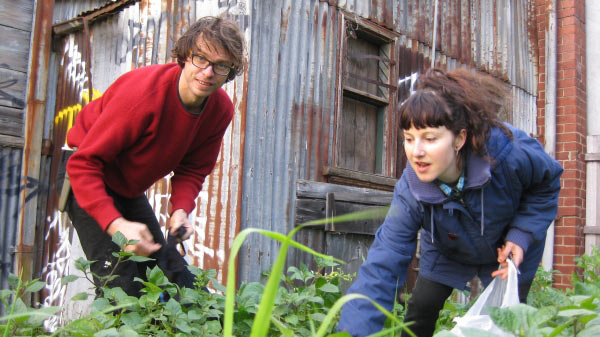
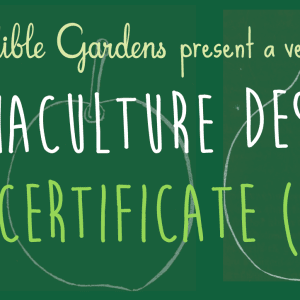

This is helpful, thank you. I live in the US and work with edible fruits, nuts, and berries. What do you know of African violets as a cover crop to accumulate soil lead?
Hi Alice, sorry late reply! I’ve never heard anything about that, and can’t see anything in a Google Scholar search for ‘Saintpaulia’ and lead accumulation. There are some scientific studies that show certain plants ‘hyperaccumulating’ lead (including some brassica species). These are generally done in the lab where soluble lead salts are poured into the soil, in a way not very consistent with how lead is found in urban soils — i.e. primarily from vehicle exhaust and paint particles, in forms where it is usually much less available to plants. There are some studies of hyperaccumulation in real life — e.g., around mining sites, where soil pH isn’t especially acidic although lead levels are very very high. I have to admit I’m at the limits of my knowledge here, and would welcome anyone with deeper knowledge to comment about studies like this: https://www-sciencedirect-com/science/article/pii/S0160412005000371
Such a helpful article – thank you!
Thanks for this article!
I was wondering your thoughts on my current sitch.
I’ve recently moved into my place and I wanted to get some things in the ground so have planted stuff without doing any of the above things (the soil isn’t the greatest either). I’ve planted zucchini, kale, silver beet, pumpkin, tomatoes, beans and some spring onions.
I just got my Macquarie Uni soil test results back and the results range from 213-540ppm for lead (average is 348ppm).
What would be your advice on eating the things already established in my garden?
I’m wondering if I should pull out the greens (would spring onion be included in this?) as I haven’t improved the soil at all yet so their uptake of lead may be higher. Perhaps the fruiting veg will be fine though.
If you think keeping some or all of the veg is viable, what’s the best things I can do for them while they are already in the ground? Can I do number 4 and 5 around my seedlings?
Thanks so much in advance if you get a chance to reply to my many questions!
Matilda 🙂
Hi just wanted to thank you and ask if I was to buy land should I get the soil professionally tested.
If you had any reason to suspect contamination, I’d recommend it!
Great piece, thankyou. Do you know of any research on the impact of PVC/rubber content in garden hoses and soakers? Also contamination from brass tap fittings? We want our vegetable garden and fruit trees to be free from any contamination but there are many cautions but few products in Australia that deliver contamination free water.
Hi Eithne,
That’s a really good question and I think you’re probably right to have concerns. I found this article but nothing from Australia at a quick glance.
Sorry late reply!
Thankyou. Have had a scare this week that my new houses old roof was totally painted in lead and I’ve been drinking the rain water for a month.
Had been hoping to re-roof soon and use old sheets for raised gardens; now not so sure given the lead.
Thanks for the great article! I have a question that I have not been able to find an answer to and was hoping you could help. I live a 25km from the Sydney centre and away from main roads so assumed lead levels were not bad. However, recently I was digging the vegetable garden a bit deeper and came on builder’s rubbish (probably about 1950’s vintage) including a piece of lead flashing (fibro too but that’s another story). Do you know if elemental lead is likely to have leached into the soil? The acidity varies a lot in the garden but in that area it is slightly acidic.
Thanks for any advice.
If I want to have a ground level garden, can I bury or dig in raised garden beds?
trench trench
Ground level ———\ /————–\ /———
———- \_____/—————-\_____/———–